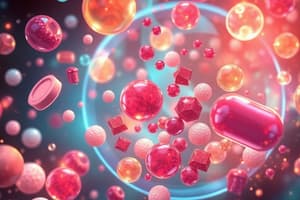Podcast
Questions and Answers
Which of the following are common classifications for drugs?
Which of the following are common classifications for drugs?
- Mechanism of action
- Therapeutic use
- Chemical structure
- All of the above (correct)
What is the primary focus of therapeutic drug classification?
What is the primary focus of therapeutic drug classification?
Intended use
What type of classification categorizes drugs based on their chemical structure and properties?
What type of classification categorizes drugs based on their chemical structure and properties?
Chemical classification
Drugs classified based on their mechanism of action can only target one specific receptor or pathway.
Drugs classified based on their mechanism of action can only target one specific receptor or pathway.
What is the main advantage of classifying drugs based on their mechanism of action?
What is the main advantage of classifying drugs based on their mechanism of action?
Which of the following factors are NOT typically considered in drug classification?
Which of the following factors are NOT typically considered in drug classification?
Which of the following is NOT a benefit of using drug classification systems?
Which of the following is NOT a benefit of using drug classification systems?
What are the three main types of drug names?
What are the three main types of drug names?
Using the brand name of a drug is always preferred over using the generic name.
Using the brand name of a drug is always preferred over using the generic name.
What is a potential limitation of using drug classification systems?
What is a potential limitation of using drug classification systems?
Drug classification systems are static and remain unchanged over time.
Drug classification systems are static and remain unchanged over time.
Why is it important to consider a drug's mechanism of action?
Why is it important to consider a drug's mechanism of action?
Flashcards
Drug Classification Systems
Drug Classification Systems
Categorization of drugs based on their chemical structure, mechanism of action, therapeutic use, and other factors.
Therapeutic Classification
Therapeutic Classification
Categorizes drugs based on their intended use (diseases they treat).
Chemical Classification
Chemical Classification
Organizes drugs based on their chemical structure and properties.
Mechanism-Based Classification
Mechanism-Based Classification
Signup and view all the flashcards
Drug Nomenclature
Drug Nomenclature
Signup and view all the flashcards
Chemical Name
Chemical Name
Signup and view all the flashcards
Generic Name
Generic Name
Signup and view all the flashcards
Brand Name
Brand Name
Signup and view all the flashcards
Antihypertensives
Antihypertensives
Signup and view all the flashcards
Analgesics
Analgesics
Signup and view all the flashcards
Therapeutic Use
Therapeutic Use
Signup and view all the flashcards
Drug Interactions
Drug Interactions
Signup and view all the flashcards
Pharmacokinetic Properties
Pharmacokinetic Properties
Signup and view all the flashcards
Limitations of Classifications
Limitations of Classifications
Signup and view all the flashcards
Multiple Mechanisms
Multiple Mechanisms
Signup and view all the flashcards
Overlapping Indications
Overlapping Indications
Signup and view all the flashcards
Drug Efficacy
Drug Efficacy
Signup and view all the flashcards
Side Effects
Side Effects
Signup and view all the flashcards
Mechanism of Action
Mechanism of Action
Signup and view all the flashcards
Ion Channels
Ion Channels
Signup and view all the flashcards
Receptor Agonists
Receptor Agonists
Signup and view all the flashcards
Receptor Antagonists
Receptor Antagonists
Signup and view all the flashcards
Enzyme Inhibitors
Enzyme Inhibitors
Signup and view all the flashcards
Antibiotics
Antibiotics
Signup and view all the flashcards
Hypoglycemics
Hypoglycemics
Signup and view all the flashcards
Study Notes
Drug Classification Systems
- Drug classification systems categorize drugs based on their chemical structure, mechanism of action, therapeutic use, or other factors.
- Different classification systems exist, each with its own advantages and disadvantages.
- Classification systems aid in understanding drug actions and potential interactions.
- Common classifications include those based on therapeutic use (e.g., antihypertensives, analgesics), chemical structure (e.g., benzodiazepines), and mechanism of action (e.g., ACE inhibitors).
Therapeutic Classification
- This approach categorizes drugs based on their intended use.
- It's frequently used in clinical practice.
- Drugs are grouped based on the disease or condition they treat.
- Examples include: antihypertensives to lower blood pressure, antibiotics to treat bacterial infections, and hypoglycemics to treat diabetes.
- This categorization facilitates quicker identification of a suitable drug for a given ailment.
- However, a drug may have multiple therapeutic applications, blurring the lines of categorization.
Chemical Classification
- This method groups drugs based on their chemical structure and properties.
- Identifying similarities in chemical structures can indicate shared mechanisms of action and pharmacological properties.
- An example: Sulfonamides are classified based on common chemical structures; they share a sulfonamide functional group, often showing similar characteristics.
- Knowing a drug's chemistry helps in understanding how it's metabolized and its interactions with targets within the body.
- May not always directly reflect the therapeutic effects.
Mechanism-Based Classification
- This approach is based on the biochemical pathway or receptor the drug influences.
- Examples include: drugs which function as enzyme inhibitors, receptor agonists or antagonists.
- Drugs targeting specific receptors, like beta-blockers, can have diverse therapeutic applications, reflecting the complex interplay between medicine and physiology.
- This approach is useful for understanding drug efficacy and potential side effects arising from actions on specific biological pathways.
- Can be complex, depending on the number of mechanisms involved.
Other Classification Systems
- Classification can be based on various other factors, including:
- Pharmacokinetic properties (absorption, distribution, metabolism, excretion).
- Specific targets, like ion channels, receptors, enzymes.
- Route of administration (e.g., oral, intravenous).
- Each classification system has value and helps in various aspects of drug understanding and prescribing.
- These systems may overlap and be interconnected in their purpose
Importance of Drug Classification
- Drug classification aids in quick identification and selection for specific conditions.
- Understands potential interactions based on similarities in drug class.
- Understanding potential side effects based on mechanism and target.
- Organizes information for better memorization and use in practice.
- Facilitate research on drug properties and efficacy.
- Improves diagnoses, treatments, and management strategies.
Limitations of Drug Classification Systems
- Overlapping therapeutic indications for various drugs.
- Some drugs can act through multiple mechanisms.
- Drug classes may not always accurately predict or predict potential for drug interactions.
- Progress in medicine and pharmaceutical research may lead to new drug groups and classifications, making older systems obsolete or misleading over time.
Drug Nomenclature
- Drugs often have multiple names, including:
- Chemical name (complex, describing chemical structure).
- Generic name (often shorter, identifying the active components).
- Brand name (proprietary name used by the manufacturer).
- Understanding these differences is crucial for correct identification and use.
- Using the generic name is preferred for clarity and avoids confusion related to different brand names.
Studying That Suits You
Use AI to generate personalized quizzes and flashcards to suit your learning preferences.




